UTIs in Children: Symptoms, Causes, Treatment & Prevention Guide

Urinary Tract Infections (UTIs) in children are more common than many parents realize. These infections can affect infants, toddlers, and school-aged children, often causing discomfort, fever, or even more serious complications if not treated quickly. Understanding the early signs, possible causes, and treatment options can help parents and caregivers protect their child’s health with confidence.
Why UTIs in Children Are a Concern
A UTI occurs when bacteria enter the urinary tract and multiply, causing infection. While adults can usually identify symptoms early, children often struggle to explain what they are feeling. This makes detection harder and delays treatment. Left untreated, infections can spread to the kidneys and cause long-term health issues. For parents, the worry of not recognizing the symptoms in time can be overwhelming.
With so much medical information scattered online, many caregivers seek trustworthy resources. In fact, just like healthcare providers rely on reliable tools such as a Medical Directory WordPress Theme to organize health-related information clearly, parents also need structured, easy-to-understand guides that help them act quickly when their child shows signs of illness.
Common Symptoms Parents Should Watch
Recognizing UTIs in children often comes down to noticing changes in everyday habits. Some of the most common symptoms include:
-
Frequent urination or sudden urges to urinate
-
Pain or burning during urination
-
Cloudy or strong-smelling urine
-
Blood in urine (even a slight tinge of pink or red should not be ignored)
-
Unexplained fever, especially in infants and toddlers
-
Irritability, crying during urination, or unusual fussiness
-
Bedwetting in children who were previously dry at night
Infants may only display vague signs like poor feeding, vomiting, or irritability, making UTIs more difficult to detect in babies.
What Causes UTIs in Children
Understanding the causes helps parents reduce risk factors. UTIs in kids often result from:
-
Bacterial spread: E. coli from the intestines is the most common culprit.
-
Poor bathroom habits: Holding urine too long or incomplete emptying of the bladder.
-
Constipation: A full bowel can press against the bladder and increase infection risk.
-
Anatomy differences: Girls are more prone due to shorter urethras, making it easier for bacteria to travel.
-
Medical conditions: Some children may have urinary tract abnormalities or vesicoureteral reflux (urine flowing backward toward the kidneys).
How Doctors Diagnose UTIs
When parents bring their child to a doctor, diagnosis usually involves:
-
Urine sample: Collected to check for bacteria, blood, or white blood cells.
-
Physical exam: Helps rule out other causes of discomfort.
-
Imaging tests: In recurrent cases, ultrasounds or other scans may be needed to look for structural issues.
Early diagnosis ensures infections don’t progress to the kidneys, where they can cause lasting damage.
Effective Treatment Options
UTIs in children are almost always treated with antibiotics. The exact type depends on the child’s age, infection severity, and urine test results. Key steps in treatment include:
-
Antibiotic course: Completing the full course even if symptoms improve.
-
Pain relief: Over-the-counter medications may be recommended to ease discomfort.
-
Hydration: Drinking plenty of fluids helps flush bacteria out.
-
Follow-up: Doctors often request another urine test after treatment to confirm the infection is gone.
Parents should never self-prescribe antibiotics for children, as inappropriate medication can make bacteria resistant.
Prevention Strategies Every Parent Can Use
Preventing UTIs is often easier than dealing with them. Simple habits can go a long way:
-
Teach children to wipe front to back after using the bathroom.
-
Encourage frequent bathroom breaks rather than holding urine.
-
Ensure children drink enough water daily.
-
Manage constipation with fiber-rich foods and hydration.
-
Avoid bubble baths or harsh soaps that can irritate the urinary tract.
-
Dress children in breathable cotton underwear to reduce moisture.
For children with recurring UTIs, doctors may recommend low-dose antibiotics or lifestyle adjustments.
When to Seek Immediate Help
Parents should contact a healthcare provider quickly if a child shows:
-
High fever with chills
-
Vomiting or refusal to drink fluids
-
Blood in urine
-
Severe abdominal or back pain
These signs may suggest a kidney infection, which requires urgent medical attention.
Helping Children Feel Comfortable
One overlooked part of treatment is easing a child’s fear. Trips to the doctor, urine tests, and medications can feel scary. Parents can reassure children by explaining things in simple terms, rewarding cooperation, and keeping a calm tone. A supportive environment reduces stress and encourages kids to speak up about future symptoms.
Final Thoughts
UTIs in children may seem minor at first, but if ignored, they can quickly escalate into serious health problems. Parents who know the symptoms, understand the causes, and follow proper treatment can protect their child’s well-being. With preventive steps and quick medical attention, most UTIs resolve without complications.
Just as reliable resources and structured tools help doctors and caregivers, having clear guidance helps parents make informed decisions for their children. By staying alert and proactive, families can ensure that urinary tract infections do not interfere with their child’s healthy growth and development.
- Art
- Causes
- Crafts
- Dance
- Drinks
- Film
- Fitness
- Food
- Juegos
- Gardening
- Health
- Home
- Literature
- Music
- Networking
- Other
- Party
- Religion
- Shopping
- Sports
- Theater
- Wellness



